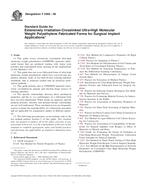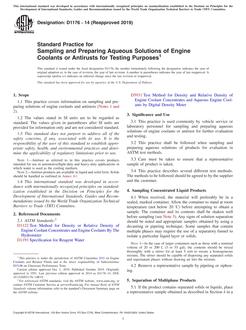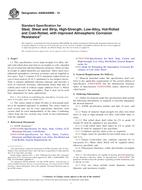1.1 This specification describes data elements and schema for an archived data management system for intelligent transportation system (ITS)-generated traffic monitoring data, including conventional traffic monitoring data, data collected directly from ITS systems, and travel-time data from probe vehicles. It establishes the names of the data elements, their interrelationships, and their procedural definitions. These procedural definitions include data collection instrumentation and methodology as well as recommended procedures for calculating traffic statistics.
1.2 This specification is intended for primary use by archived data management system (ADMS) developers and administrators. It also can be used by traffic operations and planning stakeholders who need to understand the contents of the ADMS. ITS systems exist across a variety of governmental levels, and the data archived in such a system would be available to all levels of government and the private sector, making this specification applicable to all levels of government and the private sector.
1.3 Many users might wish to develop integrated archived traffic data management systems that include both ITS-generated data and data collected from conventional traffic-monitoring programs. The latter use requires a superset of data elements to meet the articulated nature of a conventional traffic-monitoring program. This specification will describe a basic set of data elements applicable to ITS-generated traffic data and the additional data elements required for conventional traffic-monitoring programs. In the following discussion, the specification for the system for ITS-generated data will be referred to as the “basic system,“ and the one for ITS plus conventional traffic-monitoring data will be denoted the “extended system.“ Travel-time data from probe vehicles are stored in separate tables that can be linked through the roadway link identifiers.
1.4 This specification is applicable to traffic data collected by ITS and stored in an ADMS. Similarly, this specification also can be used with other types of historical and monitored traffic data collected and stored in an ADMS, including travel-time data from probe vehicles.
1.5 The applications of “near-real-time“ traffic data, such as an automated transit information system (ATIS), are not addressed in this specification. In many cases, traffic data to be archived will be provided by a real-time system, but these systems are considered data sources rather than data repositories.
1.6 This specification specifies a logical data structure for an archived traffic data management system.
1.7 Metadata requirements are specified for these systems. Actual metadata are provided for the elements defined in this specification. Placeholders are included for the metadata elements that are specific to a given installation. All metadata specifications follow the requirements of Practice E 2468.
1.8 This specification assumes the existence of quality-checked data. The quality checks to be applied should be, at a minimum, those specified in the AASHTO Guidelines for Traffic Data Programs (1), where applicable. As quality checks are developed for ITS-generated traffic data, they should be used. All checks used should be specified in the metadata for the archive.
1.9 The summary statistics stored in the archive are assumed to have been calculated in a standard way by the software that “feeds“ the archive. These standard calculations should be those specified in the AASHTO Guidelines for Traffic Data Programs (1). Any exceptions to these computational methods should be defined in the metadata for the archive.
1.10 This specification assumes the existence of a road network database but does not specify the nature of this database. Both traffic and travel-time measurements occur on a road network, but the specification of that network is outside the scope of this specification. The entities defined in this specification will specify a “link location“ or “link description“ entity that will contain foreign keys to an unspecified road network entity.
1.11 This specification assumes the existence of a location-referencing system and does not specify a standard for location referencing.
1.12 The values stated in inch-pound units are to be regarded as standard. The values given in parentheses are mathematical conversions to SI units that are provided for information only and are not considered standard.
1.13 This standard does not purport to address all of the safety concerns, if any, associated with its use. It is the responsibility of the user of this standard to establish appropriate safety and health practices and determine the applicability of regulatory limitations prior to use.
Product Details
- Published:
- 12/01/2008
- Number of Pages:
- 107
- File Size:
- 1 file , 620 KB


